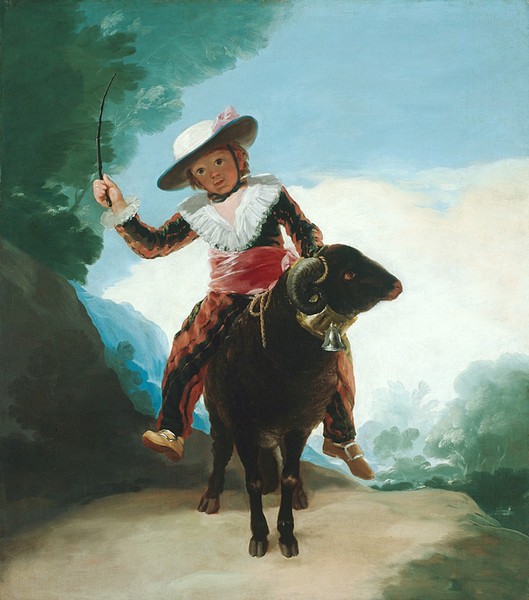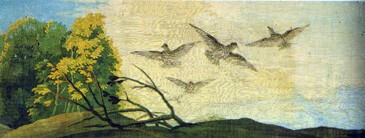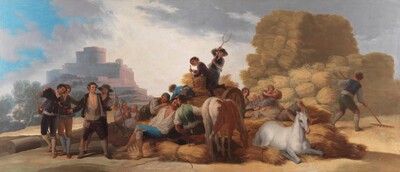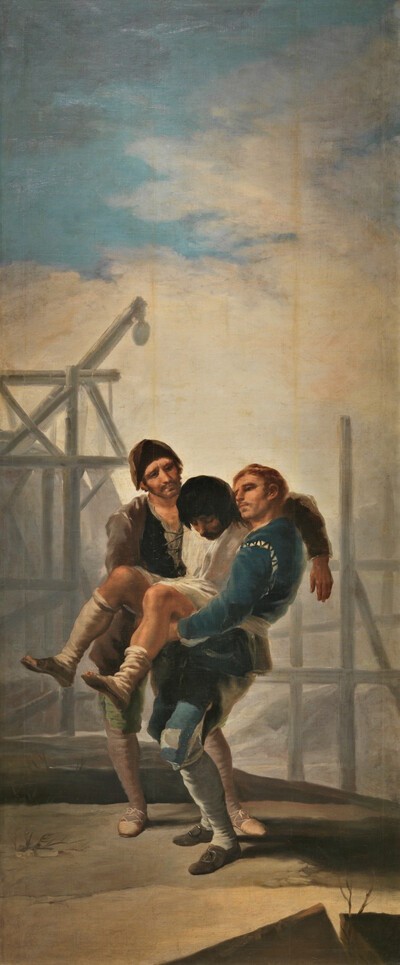- Cronología
- 1786 - 1787
- Ubicación
- The Art Institute of Chicago, Chicago, United States
- Dimensiones
- 127.2 x 112.1 cm
- Técnica y soporte
- Oil on canvas
- Reconocimiento de la autoría de Goya
- Documented work
- Titular
- The Art Institute of Chicago
- Ficha: realización/revisión
- 14 Dec 2009 / 14 Jun 2023
- Inventario
- (1979.479)
This is one of the six overdoor pieces made to decorate the king's conversation room in the palace of El Pardo and which we know of thanks to the account left by the carpenter Josef Serrano, dated 17 November 1786. The others were Boys with Hunting Dogs, Hunter beside a Spring, Shepherd Playing a Dulzaina, Two Cats Fighting on a Wall and Birds in Flight.
From the Royal Tapestry Factory it entered the private collection of the director, Livinio Stuyck. In 1911 it was sold to the Knoedler & Co. collection, in New York. Later on it was the property of Charles Deering up until 1922, when it found its way into the Chauncey Brooks Mac-Cormick collection, Chicago. Mr and Mrs Brooks donated it to the Art Institute of Chicago in 1979.
The tapestry would have hung on the west side of the room, flanking that of The Flower Girls and forming a pair with Boys with Hunting Dogs.
A boy of around ten years of age, elegantly dressed and clearly belonging to a wealthy family, rides on top of a ram whilst brandishing a branch as an improvised riding whip and advancing towards the viewer. The low viewpoint and the foreshortening, the result of the work having been designed to be viewed from below, bestow upon the figures a monumental quality. In the background, a brightly-lit landscape recalls the one which Goya would later use as the backdrop for several portraits, such as that of The Marchioness of Pontejos.
Some writers consider this cartoon, of which no sketch is known, to be a simple anecdotal representation of a boy at play. Goya's skill in portraying children, capturing their vitality and the candidness of their gaze, as well as the tenderness of their years, stands out here. This was not the first occasion that Goya painted children, and as such this virtuoso display should come as no surprise.
Tomlinson relates this cartoon to spring, due to the presence of the ram, Aries in the zodiac, the first sign of spring. She also sees a clear connection between this well-dressed boy, who resembles Manuel Osorio, and the lower nobility represented in other cartoons made for this same room. She believes that the combined representation of childhood and this unusual mount responds to the zodiacal traditions of the seasons and the ages of man.
-
Goya 1900Ministerio de Instrucción Pública and Bellas ArtesMadrid1900consultant editors Aureliano de Beruete, Alejandro Ferrant, Marqués de Pidal and Ricardo Velázquez. May 1900cat. 121
-
Pinturas de GoyaMuseo Nacional del PradoMadrid1928consultant editor Fernando Álvarez de Sotomayor. From Apri to -May 1928
-
A Century of Progress. Exhibition of Paintings and SculpturesThe Art Institute of ChicagoChicago1933from June 1st to November 1st 1933cat. 161
-
The art of Goya. Paintings, drawings and printsThe Art Institute of ChicagoChicago1941from January 30th to March 2nd 1941cat. 65
-
Obras maestras de la pintura española de los siglos XVI al XIXMuseo PushkinMoscow1980Exhibited also at the State Hermitage Museum, San Petersburgocat. 23
-
GoyaNationalmuseumStockholm1994consultant editors Juan J. Luna and Görel Cavalli-Björkman. From October 7th 1994 to January 8th 1995cat. 9
-
Goya. 250 AniversarioMuseo Nacional del PradoMadrid1996consultant editor Juan J. Luna. From March 29th to June 2nd 1996cat. 42
-
L'œuvre peint de Goya. 4 volsParís1928-1950vol. I, p. 104, cat. 45
-
Tapices de GoyaMadridPatrimonio Nacional1946pp. 141, 149, 257, cat. 46 y lám. 161
-
La pintura española fuera de EspañaMadridEspasa Calpe1958pp. 77, 161, cat. 915
-
Vie et ouvre de Francisco de GoyaParísOffice du livre1970pp. 79, 97, cat. 268
-
BarcelonaPolígrafa1970vol. I, pp. 269-270, cat. 226
-
L’opera pittorica completa di GoyaMilanRizzoli1974p. 102, cat. 206
-
Francisco de Goya, 4 vols.ZaragozaCaja de Ahorros de Zaragoza, Aragón y Rioja1980-1982vol. II, p. 43
-
Francisco de Goya, cartones y tapicescol. col. "Espasa Arte"Espasa Calpe1987pp. 147, 295, cat. 50C
-
Francisco de Goya. Los cartones para tapices y los comienzos de su carrera en la corte de Madridcol. col. "Ensayos de Arte Cátedra"MadridCátedra1987pp. 221, 222 y p. 219 (il.)
-
Goya. 250 AniversarioMadridMuseo del Prado1996p. 322, cat. 42 y p. 123 (il.)
-
Salas del Palacio Real de El Pardo para las que se tejieron tapices sobre cartones de Francisco de Goya: identificación de las habitaciones y ajuste de las obras de Goya en los alzados de las paredesin HERRERO CARRETERO, Concha (curator, Tapices y cartones de Goya (catalogue of the exhibition organizated at the Palacio Real de Madrid, from may to june 1996)MadridPatrimonio Nacional, Goya 96, Lunwerg1996p. 165 (il.)
-
Goya en Madrid. Cartones para tapices 1775-1794MadridMuseo Nacional del Prado2014p. 215









